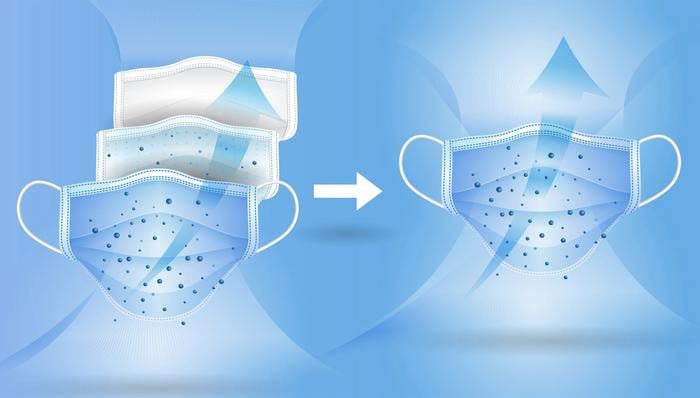Japanese researchers have developed a mask filter that solves a persistent pandemic-era problem: how to trap virus-sized particles without making breathing difficult. The innovative technology uses molecular nanosheets with precisely engineered pores to capture tiny particles while allowing air to flow freely.
The COVID-19 pandemic highlighted an uncomfortable reality for mask wearers: the more protective a mask is against small particles, the harder it typically is to breathe through it. This trade-off has now been tackled by scientists from the Institute of Industrial Science at the University of Tokyo, who published their findings this month in Materials Advances.
What makes this new filter different from traditional mask materials? The answer lies in its unique two-layer design that works at the molecular level.
How Molecular Engineering Creates Better Breathing
The researchers created a hybrid filter by combining nanosheets made of porphyrin molecules with nanofiber-modified fabrics. Porphyrins are flat, ring-shaped molecules with a central hole perfectly sized to allow air molecules through while blocking larger particles.
“The porphyrin-based nanosheets are constructed through interfacial reactions that are driven by the movement of reactants caused by the gradient of surface tension at the air–solvent interface, known as the Marangoni effect,” explains senior author Kazuyuki Ishii. “The nanosheets are then compressed and coated on nanofiber-modified fabric using a stamp method.”
This molecular architecture creates a filter with nanopores just a few nanometers in size – small enough to trap virus particles but large enough to maintain airflow. The nanosheets are then supported on fabric that’s been modified with nanofibers, providing structural stability without compromising breathability.
Performance That Exceeds N95 Standards
- The filter achieved 96% particle filtration efficiency, exceeding the 95% requirement for N95 masks
- Successfully captured particles as small as 100 nanometers – in the size range of viruses like COVID-19 (60-140 nm) and influenza
- Showed minimal increase in differential pressure, indicating easy airflow
- Maintained structural integrity through a stamping hybridization process
- Created using cost-effective materials and manufacturing techniques
When tested according to standard procedures for N95 face masks, the results were impressive. The filter not only trapped particles as small as viruses but did so with minimal impact on airflow.
“Our porphyrin-based filter collected nanoparticles with a diameter as small as one hundred nanometers,” notes Ishii. “Importantly, the filter also showed minimal decrease of differential pressure in gas flow measurements. This indicates that the filter is capable of trapping particles as small as viruses, while barely restricting air flow.”
The Science Behind the Breakthrough
Creating these nanosheets required precise control of chemical reactions. The team prepared large-area porphyrin-based nanosheets using a modified approach involving toluene and n-hexanol as the organic layer on a copper chloride solution.
What happened next was unexpected but crucial: when droplets of the porphyrin solution contacted the aqueous solution, they initially spread out in concentric circles before suddenly exploding after a brief pause. This explosion, driven by rapid chemical complexation creating a surface tension gradient (the Marangoni effect), helped form the large-area nanosheets needed for effective filtering.
The researchers found that compression of these nanosheets was essential for optimal performance. Using a technique called the Langmuir-Blodgett method, they precisely compressed the nanosheets until they formed a uniform film without defects, maximizing particle capture while maintaining airflow.
Real-World Implications Beyond Masks
While the COVID-19 pandemic was the catalyst for this research, the implications extend beyond face masks. The approach of hybridizing nanofiber-modified fabrics with molecular nanosheets opens new possibilities for filtration systems in healthcare settings, air purification systems, and industrial applications where capturing nanoparticles is crucial.
Scanning electron microscopy images clearly showed that these hybridized filters captured particles approximately 100 nanometers in size – smaller than common respiratory viruses. This capability could prove invaluable in hospital settings, cleanrooms, and other environments requiring high-efficiency air filtration.
For everyday mask users, this technology could eventually translate into face masks that offer superior protection without the discomfort of restricted breathing – a welcome development as respiratory illnesses remain an ongoing public health concern.
As we continue adapting to life with airborne pathogens, innovations like this porphyrin-based filter demonstrate how molecular engineering can solve practical problems, potentially making protective equipment both more effective and more comfortable to use.
If our reporting has informed or inspired you, please consider making a donation. Every contribution, no matter the size, empowers us to continue delivering accurate, engaging, and trustworthy science and medical news. Independent journalism requires time, effort, and resources—your support ensures we can keep uncovering the stories that matter most to you.
Join us in making knowledge accessible and impactful. Thank you for standing with us!

